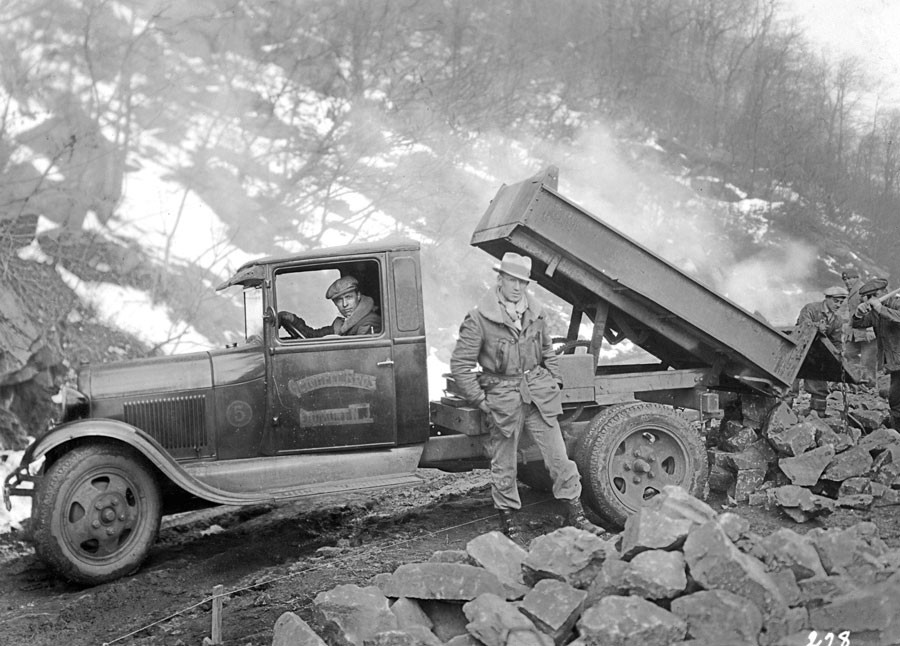Meeting the “Reel” Ghosts
A “Cliff Notes” Story by Carol Hoernlein, P.E.
November 2001
This piece is from a talk presented by Carol Hoernlein at the premier of A New Deal for the Palisades, a half-hour video produced by the staff of the Kearney House. The video features restored 16-millimeter film footage shot in the NJ Section by park workers in the 1930s and early 1940s, accompanied by narrative from park documents of the day and a “live” theater-organ score.
A New Deal for the Palisades, historic film footage and text from park documents of the day tell the story of the park’s heyday in the 1930’s!
I love this story. It is part of my family history, and a part of many of yours, too. Our grandparents and great-grandparents remember this park, even if many people living in this area are not yet familiar with this treasure called the Palisades.
This story fascinates me on many levels. One that affects me deeply is knowing that women had such an influence on saving the Palisades. Think about that a moment. When the women’s clubs helped save the Palisades, they still had another twenty years to go before they would even have the right to vote. I stand here as a civil engineer knowing that it was women like these who changed the world so much that in my lifetime, my gender hasn’t even slowed me down. They were remarkable. But it was a joint effort. I like to say that women saved the Palisades, but it was men who built the park. They did so with cheerful hard work. Backbreaking effort and sweat. As a former Youth Conservation Corps member on the Palisades in 1981, nearly half a century later, I had a glimpse into just what it was like to be one of those hard working boys you’re about to see. We owe them such gratitude for their labors. What is amazing is that we can today show you their story. It will answer so many questions you might have about who built what and when. Many areas of this park remind one of a J. R. R. Tolkien story. You see stone stairways cut into the side of this mountain we call the Palisades, and they look ancient, as if they were hewn ages ago. After seeing this footage, you will know how it really all happened.
The narration is special because it is from the same time period as the images. You will hear from the voices of that time, not our twenty-twenty hindsight. They do not know what is about to come next. In fact, many of the children you will see, playing and splashing about, are the very same young men and women we sent off to fight and serve in World War II ten years later. Many did not come back. This was their innocence.

Before we found much of this footage, we had started a modest effort to uncover and reprint some of the most interesting photos located in our darkroom. I was fascinated to find 70-year-old five-by-seven-inch negatives in such beautiful shape that we could zoom in so close to pictures of the kiddie pool that we could see expressions on the faces of these children. With the help of volunteer Paul Merino, we began darkroom work to bring some of these photos back to light. Several were turned into postcards — my favorite of course is the one I found of the two men with the truck working on construction of the Henry Hudson Drive in 1934. My sister, also trained as a civil engineer, was with me when we made the first modern print of that gem. The darkroom and archiving work is now continued with two gifted young men with wonderful photography skills. They are carefully preserving our history for us, and should be thanked for their help — Chad Hill and Tony Taranto.

In the course of cleaning the darkroom to make our work easier, reels of film turned up. To our surprise, some even in color. Needless to say, if I was impressed by just the ability to zoom in on a child’s smiling face, imagine my delight in actually now being able to see that child splashing around in the Hudson in real time. It was the difference between hearing a ghost story and being confronted with an actual ghost. I still am delighted every time I see this footage. It makes it all so real to me. I can even imagine I see my grandfather in some of these images — he would look like a young man of twenty. He is ninety now. I hope you are all as delighted as I am that we found these images and are able to show them to you today.
October 17, 2001

